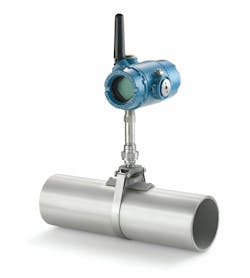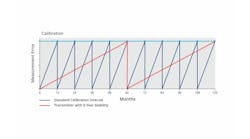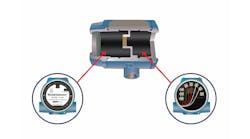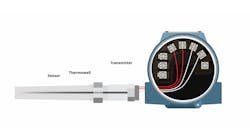In most cases, a complete process instrumentation solution for temperature measurement is comprised of three components: a transmitter, a sensor and a thermowell. Traditionally, its design comes with its share of complexity and a risk of failure if not done properly. Most of the challenge lies with the design of the thermowell, a metal alloy sheath that penetrates the process piping and protects the sensor from often harsh process conditions. Think about an oil refinery’s catalytic cracker regenerator that runs in excess of 1,000º F. Add to such high temperatures turbulent flows and fluid velocities that can flirt with the speed of sound, and one quickly appreciates the need for a well-designed thermowell.
Industry best practice is to perform thermowell wake frequency calculations, which ensure that the thermowell design will withstand the process conditions to which it is exposed. These calculations account for 75% of the overall engineering work to design and specify a complete temperature measurement point. Most of the design time is spent on the thermowell because it is the component that comes into direct contact with the process. It is also a pressure-retaining component, so a poorly designed thermowell can lead to safety concerns as well as unplanned and costly shutdowns.
Designing a thermowell is a complex task, and there are several considerations that must be factored into both the overall design and the specifications for each application. Among those considerations are allowances for material compatibility with the process as well as the mounting types and style appropriate to the application. Other considerations may revolve around your measurement objective. Is your temperature measurement intended to be used for closed-loop control or monitoring purposes?
In addition, thermowell calculations must adhere to the most current ASME PTC-19.3 TW industry standard. Most individuals are not well-versed in the requirements of the standard and could potentially design a thermowell that fails to meet these requirements.
Historically, performing such calculations included the use of manual spreadsheets and numerous manual trial-and-error iterations. This process was tedious, time-consuming and prone to errors.
Emerson developed the Rosemount™ Thermowell Design Accelerator to ease the complexities of the thermowell design process. This free, easy-to-use and intuitive online software tool can execute thermowell calculations up to 90% faster by eliminating many of the manual tasks of the past.
For example, if a user changes process specifics, they’ll have to do another calculation to ensure the thermowell isn’t affected. In the past, that required the use of trial and error and spreadsheets, resulting in a 50-tag project typically taking about 40 hours to calculate. The Rosemount Thermowell Design Accelerator can reduce that same project design time to about two hours. It is able to upload and calculate up to 1,000 thermowell tags at once and, uniquely, includes auto revision functionality, allowing the Accelerator to continue revising the thermowell dimensions after a failed calculation until it finds a passing solution.
Another feature that makes the software unique is its ability to not only recalculate failed tags, but also automatically generate thermowell and sensor model numbers that are specific to the solution that meets the application’s process conditions.
In addition, to ensure the most current standards are being used, all information from the software is based on the ASME PTC-19.3 TW standard.
Analyzing the application
Among those products are the Rosemount Twisted Square™ Thermowell and Rosemount X-well™ Technology. The Rosemount Twisted Square dampens the effects of the vibrations on the thermowell, thus making it a more robust solution. This is achieved by using a unique helical-shaped stem profile that is designed to eliminate more than 90% of the dynamic stresses that a conventional thermowell would experience. This design allows for operation at higher fluid velocities.
It is also designed to improve the reliability of a thermowell and to reduce the risk of thermowell failures with changing process conditions, including start-up, shutdown or unintended events. In addition, because of its ability to withstand harsher process conditions, the Rosemount Twisted Square allows for insertion lengths that reach the middle of the pipe for highest temperature measurement accuracy. The Rosemount Twisted Square Thermowell can easily be expanded to new applications and can reduce inventory since one thermowell fits a range of requirements.
Rosemount X-well Technology is Emerson’s non-intrusive solution to accurately measure process temperatures without using a thermowell. It features a patented thermal conductivity algorithm and, with an understanding of the thermal conductive properties of the temperature measurement assembly and piping, can calculate internal process temperatures with accuracy on par with a traditional thermowell. In addition, Rosemount X-well Technology simplifies measurement point specification, installation and maintenance while reducing possible leak points.
The Rosemount Thermowell Design Accelerator can help turn a once time-consuming and tedious process into an efficient and accurate thermowell design solution. Whether it is recommending a traditional thermowell or an alternate approach, you can trust the Rosemount Thermowell Design Accelerator to give you the best possible temperature measurement solution for your application.






